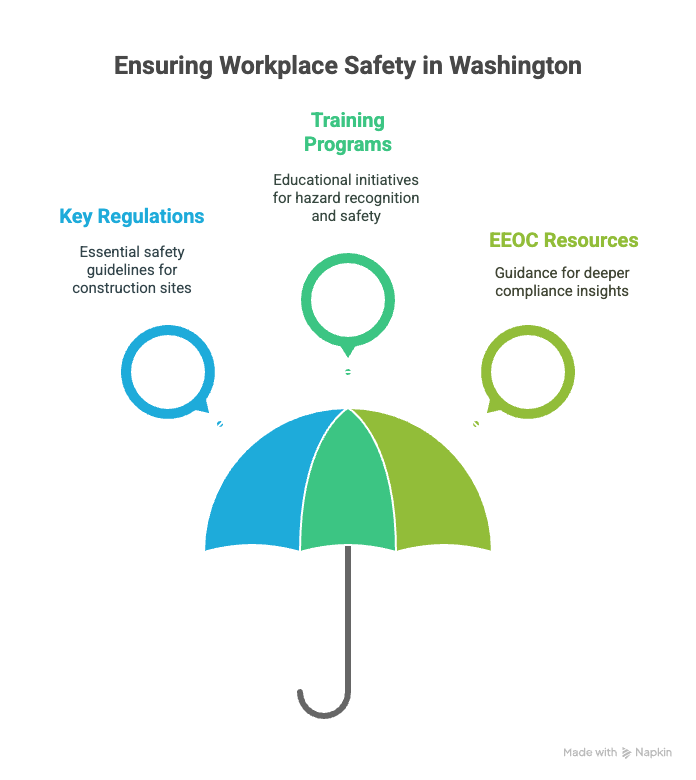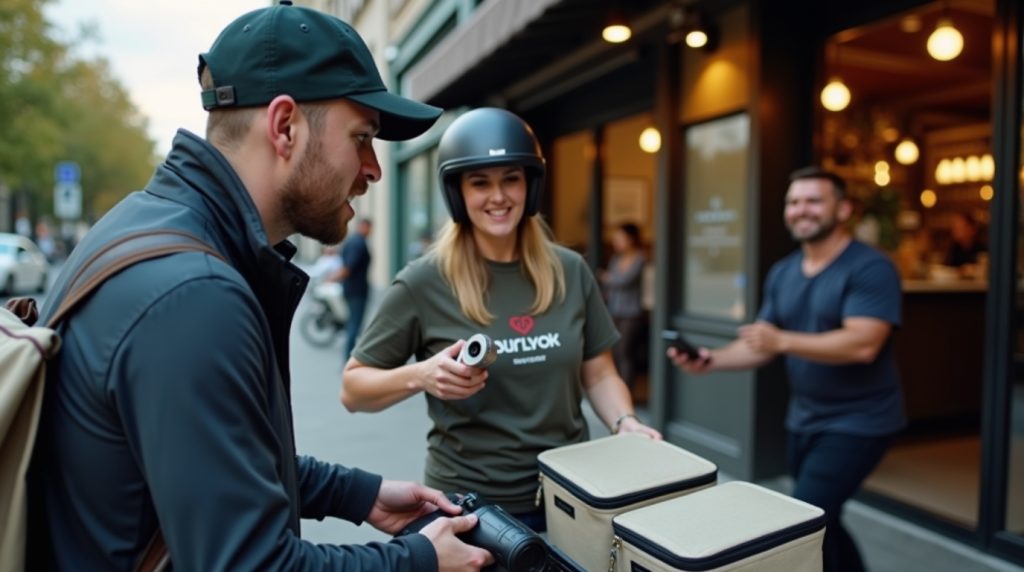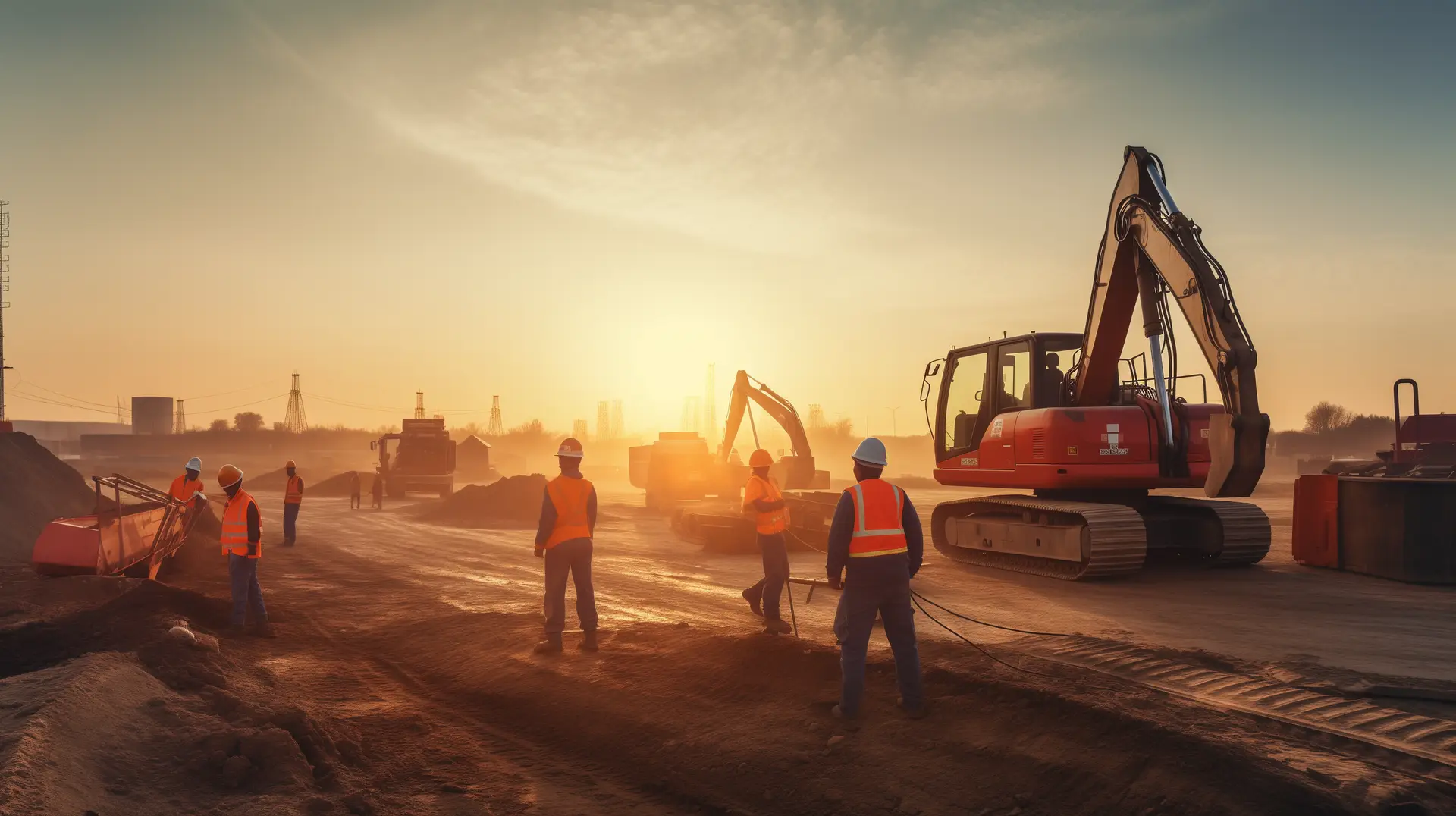Navigating the construction industry in Washington isn't just about building structures—it's also about building compliance. As a contractor or construction company based in Washington, understanding the necessary checks and adhering to regulations is crucial for success and sustainability. Whether it's securing the right licenses or ensuring safety on site, this guide will walk you through everything you need to know about Washington construction checks, focusing on L&I (Labor & Industries) requirements and OSHA compliance.
Key Takeaways
- Ensuring compliance with L&I and OSHA standards is key to avoiding fines and maintaining a safe work environment in the Washington construction industry.
- Contractor licensing in Washington requires careful attention to documentation and periodic renewals to remain in good standing.
- OSHA compliance emphasizes safety training and personal protective equipment, crucial for minimizing workplace risks.
- L&I regulations focus on worksite safety, employee compensation, and work hour standards, and being prepared for inspections can prevent costly violations.
- Developing a compliance checklist, investing in training, and maintaining organized records can help your construction business remain compliant and efficient.
Introduction
Compliance is the foundation of the construction industry in Washington. As professionals in this field, you already understand the stakes. Meeting regulatory standards isn't just a regulatory headache—it's part of the job. It's about staying open for business, avoiding penalties, and keeping your workforce safe.
L&I, short for Washington State Department of Labor and Industries, regulates worker protection and wages. OSHA, the Occupational Safety and Health Administration, mandates safety protocols. Knowing their standards is essential. These agencies set rules you need to follow to operate legally and safely.
This guide gives you a roadmap through the maze of compliance. It centers on L&I and OSHA requirements. Whether you're a seasoned contractor or new to the industry, this knowledge is crucial. Let's dive into keeping your operations compliant and safe.
Washington Construction Checks: An Overview
Washington construction checks revolve around ensuring your projects meet both legal and safety standards. At the core, these checks require adherence to state and federal laws, particularly focusing on Labor & Industries (L&I) and OSHA regulations. These checks serve as a blueprint for operating within legal bounds while maintaining safety for workers and the public alike.
Ignoring compliance can lead to dire consequences. Businesses face hefty fines, or in some cases, work on a site might grind to a halt. Such interruptions can damage your company’s reputation and profitability. Records show companies that consistently meet compliance standards often see fewer incidents on site and gain more trust from clients and partners.
The essential goal of these frameworks is to guarantee a safe, transparent, and lawful working environment. Washington construction checks enforce a level playing field, where every contractor has to meet the same benchmarks. This ensures safety is not compromised, and the quality of work remains high. By keeping up with these checks, you protect not just your business, but also your workers and the communities they work in.
Have you considered how compliance figures into your overall business strategy? Ensuring you’re aligned with these frameworks can help prevent disruptions and pave the way for smooth project execution. Have you faced challenges in maintaining compliance? Identifying weak spots and addressing them proactively can safeguard your operation’s ongoing success.
WA Contractor Licensing
Securing a contractor license in Washington requires some specific steps and attention to detail. First, gather all necessary documentation. You’ll need a completed application form, proof of identifying information, and financial responsibility evidence. Ensure you meet basic qualifications like a valid bond and insurance, especially if you're eyeing roles in general or specialty contracting.
Washington offers different licenses depending on your focus. A general contractor license suits those overseeing various trades. Meanwhile, a specialty contractor license is tailored to singular professions such as electrical or plumbing. Knowing where your expertise fits is crucial.
Licenses aren't just a one-time deal. Stay vigilant about renewals, typically every two years. Be aware of any new updates in the requirements, as the state might adjust them based on industry shifts. Keeping up with these changes is part of maintaining good standing.
Understanding these steps helps you better navigate the licensing maze. For further insights, explore this useful resource on contractor licensing from our internal blog internal link.
OSHA Compliance in Washington
OSHA is the federal agency responsible for ensuring workplace safety and health standards. For Washington-based construction companies, understanding and following OSHA regulations is vital. This involves adhering to safety guidelines that minimize risks on construction sites. Key regulations include Fall Protection, Hazard Communication, and Personal Protective Equipment (PPE) requirements. These are some of the cornerstone regulations that workers must understand to ensure safety on the job.
Every construction site needs OSHA training programs. These programs cover hazard recognition, safe equipment operation, and emergency procedures. Training isn't just about checking boxes; it's about fostering a culture where safety comes first. When everyone knows the rules and feels responsible for maintaining safety, you reduce accidents and improve job site morale. Alongside this, consider periodic refreshers to keep these issues at the forefront of employees’ minds.

If you need guidance, the EEOC offers resources for deeper insights into compliance and its benefits. This can help ensure you're not only meeting standard requirements but also creating a safer and more effective workplace. So, is your team prepared to meet these standards and create a secure environment? Compliance isn't just a regulatory hurdle; it's a path to a safer and more productive workforce.
L&I Regulations and Inspections
Understanding the Department of Labor & Industries (L&I) is vital for anyone working in the Washington construction sector. L&I is responsible for ensuring workplace safety and upholding workers' rights. For construction companies, L&I enforces various regulations aimed at creating a safe and fair working environment. Familiarize yourself with these standards to protect both your employees and your business.
Key L&I mandates in construction include rules around worksite safety conditions, employee compensation, and work hours. For instance, fall protection systems must be in place for certain types of infrastructure work. These rules are there to minimize accidents and ensure fair treatment of workers, which is crucial for maintaining site operations and avoiding costly shutdowns.
The inspection process by L&I is straightforward yet thorough. L&I inspectors may visit your site unannounced to check compliance with their regulations. They will review safety procedures, equipment, and even interview workers. Being prepared means having all compliance documents ready and ensuring site conditions meet L&I standards.
If a violation is found during an inspection, it’s important to act quickly. Address issues by rectifying any problems and then formally responding to the violation notice from L&I. Document all corrective actions taken and consult with L&I if you need clarification on compliance standards. This proactive approach can prevent further penalties and demonstrate your commitment to maintaining a safe work environment.
Best Practices for Compliance
Creating a compliance checklist is a simple yet effective way to ensure that you meet both L&I and OSHA requirements. A detailed checklist can help streamline processes, identify gaps, and prioritize tasks. This proactive approach aids in maintaining high standards both on and off the construction site.
Incorporate training and development as part of your regular routine. Regulations evolve, and keeping your team updated is crucial. Regular workshops and courses make sure everyone stays informed of changes and knows exactly what’s expected.
Good record-keeping is essential. It’s not just about having records; it’s about maintaining them in an organized fashion. Accurate logs of incidents, training sessions, and safety checks can be the difference between passing an audit and facing penalties. They serve as evidence of compliance and can be instrumental in defending against any unfounded claims.

Embrace a culture of continuous improvement. Encourage feedback from your team and act on it. Regulations aren’t static, and neither should your approach be. Staying informed about updates and industry trends can be key to staying ahead. Actively seeking out innovations and improvements can set you apart as a leader in safety and compliance.
Common Challenges and Solutions
Compliance challenges in the construction industry aren't rare. As a contractor, you might face various hurdles in ensuring that your operations meet all necessary regulations. One frequent issue is keeping up with the ever-changing rules and standards. The regulatory landscape can shift rapidly, leaving you scrambling to adjust. To tackle this, establish a compliance team. This team can monitor updates and seamlessly integrate new requirements, keeping your projects on track and avoiding penalties.
Another common obstacle is insufficient training. Employees unaware of safety protocols can pose risks. Investing in regular training sessions can fix this. Encourage participation in OSHA workshops and L&I seminars, making sure your team stays informed about the latest safety practices. A well-trained crew not only improves compliance but also reduces accident rates, saving costs in long run.
Inspections can also be stressful if you're unprepared. Often, inspections result in violations simply due to lack of documentation. Implementing an efficient record-keeping system can alleviate this issue. Digitize records if possible. A cloud-based system can make records easily accessible and secure, keeping you ready for any unannounced inspections.
Take, for example, a local contractor who faced $20,000 in fines due to documentation errors. By adopting a comprehensive digital record system and regular checklists, the company not only avoided further fines but also increased efficiency across its projects. Simple yet effective changes like these can lead to substantial improvements.
When confronted with compliance issues, it's vital to remain proactive. Which strategy will you apply first to ensure your business remains compliant and successful?
Conclusion
Complying with Washington construction checks requires diligence and proactive planning in your operations. When you align your practices with L&I and OSHA standards, you significantly reduce risks and enhance the safety of your workforce. Reflect on the importance of each step detailed in this guide. Implement a compliance checklist, invest in regular training, and commit to thorough record-keeping. These practices form the backbone of a compliant operation. Prioritize these actions, and transform potential compliance obligations into opportunities for growth and stability. For further insights and assistance, explore additional resources that can guide you in maintaining an excellent standard of safety and integrity in your construction projects.
Frequently Asked Questions (FAQs)
What disqualifies you from construction work in WA?
Being disqualified from construction work often involves issues like drug offenses, severe criminal convictions, or unsafe work practices. Each case is assessed based on the severity and relevance to construction work.
Do WA contractors need background checks?
Yes, many employers in WA conduct background checks to ensure safety standards and reliability. These checks often include criminal history and other relevant information.
Can a felony prevent contractor licensing in WA?
Felonies can impact your ability to obtain a contractor's license. The specific nature of the felony and how much time has passed since the conviction are considered.
How often do WA construction sites drug test?
Drug testing frequency varies by company policy. Some sites conduct pre-employment testing, while others perform random or incident-related tests.
Are OSHA violations visible on WA checks?
OSHA violations, while not directly part of a background check, can be accessed through specific records requests and might impact employment if found.
Can you work construction with a DUI in WA?
A DUI does not automatically ban you from construction work, but it may influence hiring decisions or job duties, especially if driving is involved.
Do independent contractors need checks in WA?
Independent contractors are not universally required to undergo background checks, but clients may request them to ensure safety and trustworthiness.
How to verify OSHA certifications in Washington?
You can verify OSHA certifications through the OSHA Outreach Training Program website or by contacting the training provider directly.
Are expunged records considered for WA licenses?
Expunged records are typically not considered in the licensing process, allowing for a fresh start in most scenarios.
What's the cost of construction checks in WA?
Costs vary based on the depth of the check. Basic checks can be as low as $20, while more comprehensive ones might exceed $100.
Can you work on a construction site if you have poor credit?
Poor credit is generally not a factor for typical construction roles but can affect roles that require financial responsibilities.
Are safety certifications required for all construction workers in WA?
Not all workers need them, but roles involving specific equipment or tasks often require safety certifications.
Can a non-citizen work in construction in WA?
Yes, with the proper work authorization and adherence to immigration laws, non-citizens can work in construction.
What education is needed for a construction career in WA?
While many jobs provide on-the-job training, technical programs, apprenticeships, or a degree in construction management can enhance job prospects.
Definitions
Compliance
Compliance means meeting all required legal, safety, and employment regulations set by agencies like OSHA and the Washington State Department of Labor & Industries (L&I). In construction, this includes things like following fall protection rules, maintaining up-to-date records, and ensuring proper safety training for your team. Staying compliant helps you avoid fines, keep your projects running, and protect your workers.
Licensing
Licensing is the official approval contractors need to operate legally in Washington. To get a license, you must submit an application, provide proof of insurance and bonding, and meet any job-specific qualifications. General contractor licenses cover multiple trades, while specialty licenses focus on fields like plumbing or electrical. You need to renew your license every two years and stay updated on state changes.
Safety Training
Safety training is the process of educating workers on how to identify and prevent workplace hazards. In construction, this often includes OSHA-approved courses on fall risks, hazards from chemicals, equipment use, and emergency responses. Providing regular training reduces accidents, lowers costs, and helps you meet legal standards. Ask yourself—when was your last team refresher?
Record-Keeping
Record-keeping involves maintaining organized documentation of safety checks, training sessions, work injuries, and inspections. Well-kept records help show compliance during audits or inspections. Going digital can save time and prevent loss. A cloud-based system makes it easier to access and update files across multiple job sites.
Inspection
An inspection is a review—usually unannounced—by agencies like L&I to check if your site follows required safety and employment laws. Inspectors may talk to workers, check documents, and evaluate overall site conditions. If they find issues, you'll be expected to fix them quickly. Being inspection-ready means fewer disruptions and less risk of penalties. What steps have you taken to prepare?
Original Article Section & Enhanced Version With Study Links
References
- Washington State Workplace Safety Laws: The Complete Guide for Employers https://www.employerpass.com/employer-insights/washington-workplace-safety
- A Contractor's Guide to OSHA Construction Safety for Washington https://blog.oshaonlinecenter.com/a-contractor-s-guide-to-osha-construction-safety-for-washington/
- Sanitary Conditions for Construction Workers Public Hearing (L&I, March 2025) https://www.lni.wa.gov/safety-health/safety-rules/rulemaking-stakeholder-information/ConstructionSanitation/ConstructionSanitationInPersonPresentationMarch2025.pdf
Still have questions?
Get in touch with our team today for a personalized demo and discover how our tailored volume pricing and packages can drive results for your business!
How useful was this page?*
Note: your comments are anonymous. We use them to improve the website. Do not include any personal details.
Visit our FCRA Compliance Tool or leave a message here if you need a response.
From the blog Explore the GCheck Content Hub

FACIS Background Check: 2026 Healthcare Compliance Guide
18 Dec, 2025 • 20 min read
Food Delivery Driver Background Check: Complete Compliance Guide for Restaurant Operators
17 Dec, 2025 • 17 min read
Texas Education Background Checks: 2026 TEA Compliance Guide for Schools & Districts
17 Dec, 2025 • 23 min readThe information provided in this article is for general informational and educational purposes only and should not be construed as legal advice or a substitute for consultation with qualified legal counsel. While we strive to ensure accuracy, employment screening laws and regulations—including but not limited to the Fair Credit Reporting Act (FCRA), Equal Employment Opportunity Commission (EEOC) guidelines, state and local ban-the-box laws, industry-specific requirements, and other applicable federal, state, and local statutes—are subject to frequent changes, varying interpretations, and jurisdiction-specific applications that may affect their implementation in your organization. Employers and screening decision-makers are solely responsible for ensuring their background check policies, procedures, and practices comply with all applicable laws and regulations relevant to their specific industry, location, and circumstances. We strongly recommend consulting with qualified employment law attorneys and compliance professionals before making hiring, tenant screening, or other decisions based on background check information.

